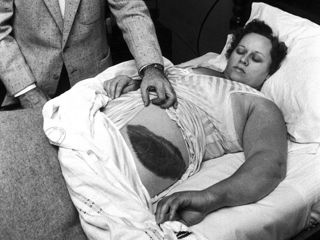
The Woman Who Was Hit By A Space Rock And Lived
- 30th Dec 2021
- Author: Alex Thompson
Every year thousands of meteorites head towards our Earth. Only a few hundred survive the trip through the atmosphere, and luckily for us most of the remaining rocks land in uninhabited areas such as the sea or a desert. Only a handful are retrieved each year.
Can you imagine how unlucky you must be to not only be in the area of a meteorite strike, but actually be hit by the rock itself? The odds are astronomically slim, but it is possible. And on 30 November 1954 these odds went against Ann Hodges – the only person in recorded history to be struck by a meteorite (don’t worry, she lived).
What are the Odds?
Before we get to Ann, lets talk more about those odds. Astronomer Alan Harris estimated that the chances of being killed by a meteorite impact at any point in your life is one in 700,000. In comparison the odds of being struck by lightning is about 300,000 to one, with your chances of winning the UK Lotto hovering at around one in 45 million. Suddenly being struck by a space rock doesn’t seem too improbable, but before you scrumple up that lucky dip ticket there’s a couple of extra factors we should consider.
Firstly, every couple of thousand years a meteoroid the size of a football pitch hits the Earth, whilst every few million years a rock comes along so big it threatens the very existence of life itself. In 1908 the largest meteorite impact in recorded history, the Tunguska event, struck an area of Russia and flattened 80 million trees. If it had hit a nearby city the number of deaths would almost certainly had been in the thousands. And we all know what happened to the dinosaurs all those years ago. The number of fatalities in these situations are taken into consideration in the odds too, so it’s probable that here on Earth we could go hundreds or even thousands of years without a human being killed by a flying space rock, before a large event causes multiple fatalities at once.
Which brings us to point two; a meteorite doesn’t have to hit a person directly to kill them. A large enough collision nearby could cause fatal damage. All of which makes the events of that fateful day in 1954 – and Ann Hodges’ survival – all the more astounding.
The Hodges Meteorite
It was the Tuesday after Thanksgiving and Ann Hodges was taking a nap in the Alabama house she rented with her husband, Eugene. It was then that an 8.5 pound chunk of space rock, believed to have broken off the asteroid 1685 Toro, crashed through the ceiling, deflected off her stand-up console radio and hit Hodges’ hip. The impact left a large grapefruit-shaped bruise on Ann, with the fact it was slowed by the roof and radio likely preventing more severe injury, as well as the protection offered by the blanket she was sleeping under.
Hodges became a local celebrity for a short time with crowds gathering around her house to see the damage. She later donated the meteorite to the Alabama Museum of Natural History after becoming ‘fed up’ with the whole thing, following unwanted media attention and a lawsuit with her landlord for ownership of the rock. Whether Ann was lucky or unlucky is open to interpretation, with astronomer Michael Reynolds commenting that such a collision – as well as surviving it – is less likely than “getting hit by a tornado and a bolt of lightning and a hurricane all at the same time.”
From Leicestershire to Russia
Ann may have been lucky (or not), but scientists are working ways to give us more protection from asteroids and meteorites in the future. Warning shots have been fired in the years since those events in Alabama:
On Christmas Eve 1965 the UK’s largest meteorite fall was recorded in Barwell, Leicestershire, less than 15 miles away from the future site of the National Space Centre. It caused minor damage around the village, including to a car; the owner threw the rock into a neighbouring field before unsuccessfully trying to find it again once he realised what it was. A near 3.5 kg sample of the fall is on display at the National Space Centre (not believed to be the one the gentleman discarded).
In 2013 the largest natural object to enter Earth’s atmosphere since Tunguska exploded over Chelyabinsk, Russia, producing around thirty times more energy than the atomic bomb that detonated at Hiroshima. Over 7,000 buildings were affected and 1,500 injured, though none from the rock itself but by indirect effects such as glass from smashed windows.
Planetary Defence
On 24 November 2021, NASA launched their DART mission towards the asteroid Dimorphos. Arriving in September 2022, DART will attempt to deflect the asteroid to knock it off its natural course, and whilst Dimorphos is no threat to Earth itself a successful strike could prove the technique’s capabilities for use in emergencies in the future. This, combined with the previously discussed high odds of being struck by a meteorite, should hopefully give you enough comfort to sleep easy at night. Though you may want to use the extra thick duvet to be on the safe side.
About the author: Alex Thompson is a Space Communications Presenter at the National Space Centre.







